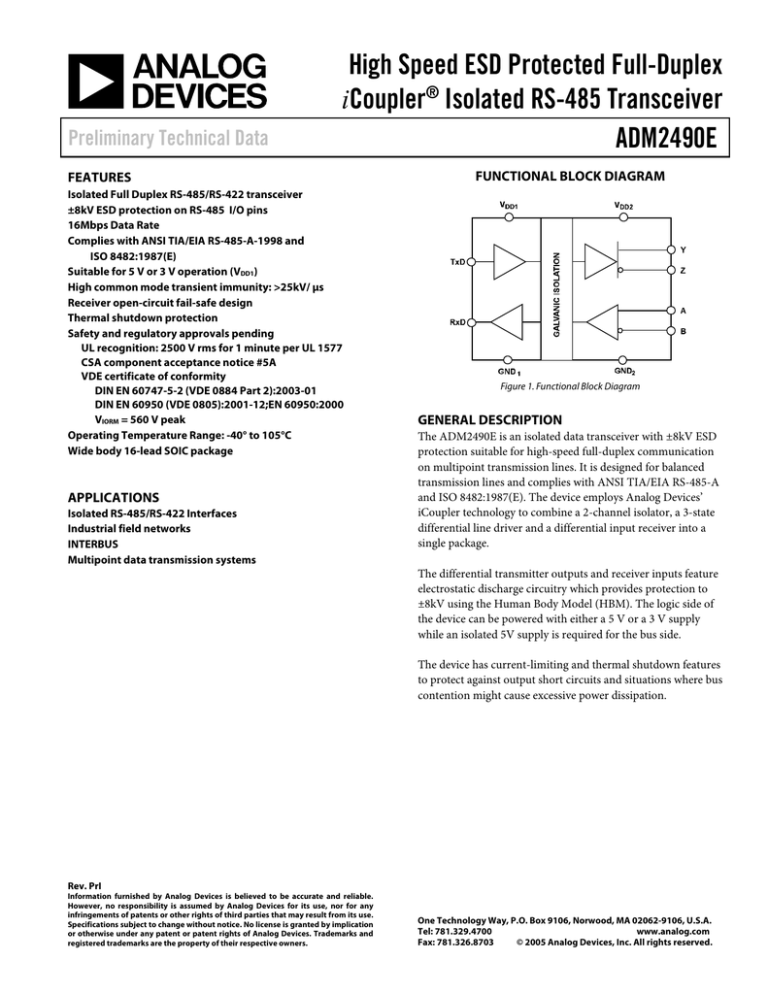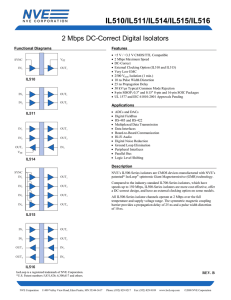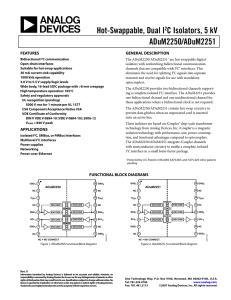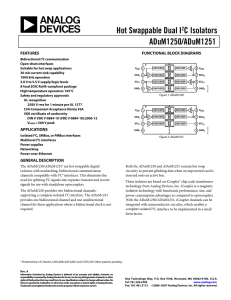
Preliminary Technical Data
High Speed ESD Protected Full-Duplex
iCoupler® Isolated RS-485 Transceiver
ADM2490E
FEATURES
Isolated Full Duplex RS-485/RS-422 transceiver
±8kV ESD protection on RS-485 I/O pins
16Mbps Data Rate
Complies with ANSI TIA/EIA RS-485-A-1998 and
ISO 8482:1987(E)
Suitable for 5 V or 3 V operation (VDD1)
High common mode transient immunity: >25kV/ μs
Receiver open-circuit fail-safe design
Thermal shutdown protection
Safety and regulatory approvals pending
UL recognition: 2500 V rms for 1 minute per UL 1577
CSA component acceptance notice #5A
VDE certificate of conformity
DIN EN 60747-5-2 (VDE 0884 Part 2):2003-01
DIN EN 60950 (VDE 0805):2001-12;EN 60950:2000
VIORM = 560 V peak
Operating Temperature Range: -40° to 105°C
Wide body 16-lead SOIC package
APPLICATIONS
Isolated RS-485/RS-422 Interfaces
Industrial field networks
INTERBUS
Multipoint data transmission systems
FUNCTIONAL BLOCK DIAGRAM
Figure 1. Functional Block Diagram
GENERAL DESCRIPTION
The ADM2490E is an isolated data transceiver with ±8kV ESD
protection suitable for high-speed full-duplex communication
on multipoint transmission lines. It is designed for balanced
transmission lines and complies with ANSI TIA/EIA RS-485-A
and ISO 8482:1987(E). The device employs Analog Devices’
iCoupler technology to combine a 2-channel isolator, a 3-state
differential line driver and a differential input receiver into a
single package.
The differential transmitter outputs and receiver inputs feature
electrostatic discharge circuitry which provides protection to
±8kV using the Human Body Model (HBM). The logic side of
the device can be powered with either a 5 V or a 3 V supply
while an isolated 5V supply is required for the bus side.
The device has current-limiting and thermal shutdown features
to protect against output short circuits and situations where bus
contention might cause excessive power dissipation.
Rev. PrI
Information furnished by Analog Devices is believed to be accurate and reliable.
However, no responsibility is assumed by Analog Devices for its use, nor for any
infringements of patents or other rights of third parties that may result from its use.
Specifications subject to change without notice. No license is granted by implication
or otherwise under any patent or patent rights of Analog Devices. Trademarks and
registered trademarks are the property of their respective owners.
One Technology Way, P.O. Box 9106, Norwood, MA 02062-9106, U.S.A.
Tel: 781.329.4700
www.analog.com
Fax: 781.326.8703
© 2005 Analog Devices, Inc. All rights reserved.
ADM2490E
Preliminary Technical Data
ADM2490E—SPECIFICATIONS
Table 1. All voltages are relative to their respective ground; 2.7 ≤ VDD1 ≤ 5.5 V, 4.5 V ≤ VDD2 ≤ 5.5 V. All min/max specifications
apply over the entire recommended operation range unless otherwise noted. All typical specifications are at TA = 25°C,
VDD1=VDD2=5.0 V unless otherwise noted.
Parameter
SUPPLY CURRENT
Power Supply Current Logic Side
Symbol
TxD/RxD Data Rate < 2 Mbps
Bus Side
Power Supply Current Bus Side
DRIVER
Differential Outputs
Differential Output Voltage, Loaded
IDD1
IDD2
∆|VOD| for Complementary Output States
Common Mode Output Voltage
∆|VOC| for Complementary Output States
Short Circuit Output Current
Logic Inputs
Input Threshold Low
Input Threshold High
TxD Input Current
RECEIVER
Differential Inputs
Differential Input Threshold Voltage
Input Voltage Hysteresis
Input Current (A, B)
Line Input Resistance
Logic Outputs
Output Voltage Low
Output Voltage High
|VOD2|
|VOD4|
∆|VOD|
VOC
∆|VOC|
IOS
VILTxD
VIHTRxD
ITxD
VTH
VHYS
II
RIN
VOLRxD
VOHRxD
Min
Typ
2.0
1.5
1.5
Max
Unit
Test Conditions
3.0
mA
2.7V≤VDD1≤5.5V
4.0
mA
Unloaded
5.0
5.0
5.0
0.2
3.0
0.2
200
V
V
V
V
V
V
mA
R=50Ω, (RS-422), Fig. 3
R = 27 Ω (RS-485), Fig 3
-7V≤Vtest1≤12V, Fig. 4
RL=54Ω or 100Ω, Fig. 3
RL=54Ω or 100Ω, Fig. 3
RL=54Ω or 100Ω, Fig. 3
0.7VDD1
10
V
V
µA
0.25VDD1
-10
0.01
-0.2
0.2
70
1.0
-0.8
12
VDD1 - 0.3
Rev. PrI | Page 2 of 13
0.0
VDD1-0.2
0.4
V
mV
mA
mA
kΩ
VOC=0V
VOC=12V
VOC=-7V
V
V
IORxD=4mA, VA-VB=-0.2V
IORxD=-1.5 mA, VA-VB=0.2V
Preliminary Technical Data
TIMING SPECIFICATIONS (T
A
ADM2490E
= -40°C to +85°C)
Parameter
DRIVER
Maximum Data Rate
Propagation Delay
Pulse Width Distortion, PWD=|tPYLH-tPYHL|,
PWD=|tPZLH-tPZHL|
Symbol
Typ
Max
Unit
Test Conditions
60
7
Mbps
ns
ns
RL=54Ω, CL1=C L2=100pF, Fig. 5
RL=54Ω, CL1=C L2=100pF, Fig. 5
20
ns
RL=54Ω, CL1=C L2=100pF, Fig. 5
60
10
ns
ns
CL=15pF, Fig. 6
CL=15pF, Fig. 6
Unit
Test Conditions
60
Mbps
ns
RL=54Ω, CL1=C L2=100pF, Fig. 5
9
ns
RL=54Ω, CL1=C L2=100pF, Fig. 5
35
ns
RL=54Ω, CL1=C L2=100pF, Fig. 5
60
10
ns
ns
CL=15pF, Fig. 6
CL=15pF, Fig. 6
16
tPLH, tPHL
tPWD,
tPWD
tR, tF
Single Ended Output Rise/Fall Time
RECEIVER
Propagation Delay
Pulse Width Distortion, PWD=|tPLH-tPHL|,
TIMING SPECIFICATIONS (T
Min.
45
tPLH, tPHL,
tPWD,
A
= -40°C to +105°C)
Parameter
DRIVER
Maximum Data Rate
Propagation Delay
Symbol
Min.
Typ
Max
10
Pulse Width Distortion, PWD=|tPYLH-tPYHL|,
PWD=|tPZLH-tPZHL|
Single Ended Output Rise/Fall Time
RECEIVER
Propagation Delay
Pulse Width Distortion, PWD=|tPLH-tPHL|,
45
tPYLH, tPYHL,
tPZLH, tPZHL
tPWD,
tPWD
tR, tF
tPLH, tPHL,
tPWD,
ABSOLUTE MAXIMUM RATINGS
Table 2. Ambient temperature = 25 °C unless otherwise noted.
All voltages are relative to their respective ground.
Parameter
Storage temperature
Ambient operating temperature
VDD1
VDD2
Logic input voltages
Bus terminal voltages
Logic output voltages
Average output current, per pin
ESD (human body model) on
A,B,Y and Z pins
θJA Thermal Impedance
Rating
-55°C to 150°C
-40°C to 105°C
−0.5 V to +7 V
−0.5 V to +6 V
-0.5V to VDD1 + 0.5V
-9V to 14V
-0.5V to VDD1 + 0.5V
±35mA
±8kV
Stresses above those listed under Absolute Maximum Ratings
may cause permanent damage to the device. This is a stress
rating only. Functional operation of the device at these or any
other conditions above those listed in the operational sections
of this specification is not implied. Exposure to absolute
maximum rating conditions for extended periods may affect
device reliability. Absolute maximum ratings apply individually
only, not in combination.
73°C/W
Rev. PrI | Page 3 of 13
ADM2490E
Preliminary Technical Data
ADM2490E CHARACTERISTICS
PACKAGE CHARACTERISTICS
Table 3.
Parameter
Resistance (Input-Output)1
Capacitance (Input-Output)1
Input Capacitance2
Input IC Junction-to-Case Thermal Resistance
Output IC Junction-to-Case Thermal Resistance
1
2
Symbol
RI-O
CI-O
CI
θJCI
θJCO
Min
Typ
1012
3
4
33
28
Max
Unit
Ω
pF
pF
°C/W
°C/W
Test Conditions
f = 1 MHz
Thermocouple located at
center of package underside
Device considered a two-terminal device: Pins 1, 2, 3, 4, 5, 6, 7, and 8 shorted together, and Pins 9, 10, 11, 12, 13, 14, 15, and 16 shorted together.
Input capacitance is from any input data pin to ground.
REGULATORY INFORMATION
The ADM2490E is to be approved by the following organizations:
Table 4.
Organization
UL
Approval Type
To be recognized under 1577 component recognition program.
Notes
In accordance with UL1577, each ADM2490E
is proof-tested by applying an insulation
test voltage ≥3000 V rms for 1 second (current
leakage detection limit = 5 µA).
CSA
VDE
To be approved under CSA Component Acceptance Notice #5A.
To be certified according to DIN EN 60747-5-2 (VDE 0884 Part 2): 2003-01
In accordance with VDE 0884, each
ADM2490E is proof-tested by applying an
insulation
test voltage ≥1050 VPEAK for 1 second
(partial discharge detection limit = 5 pC).
INSULATION AND SAFETY-RELATED SPECIFICATIONS
Table 5.
Parameter
Rated Dielectric Insulation Voltage
Minimum External Air Gap (Clearance)
Symbol
L(I01)
Value
2500
7.45 min
Unit
V rms
mm
Minimum External Tracking (Creepage)
L(I02)
8.1 min
mm
Minimum Internal Gap (Internal Clearance)
Tracking Resistance (Comparative Tracking Index)
Isolation Group
CTI
0.017 min
>175
IIIa
mm
V
Rev. PrI | Page 4 of 13
Conditions
1-minute duration.
Measured from input terminals to output
terminals, shortest distance through air.
Measured from input terminals to output
terminals, shortest distance along body.
Insulation distance through insulation.
DIN IEC 112/VDE 0303 Part 1.
Material Group (DIN VDE 0110, 1/89,).
Preliminary Technical Data
ADM2490E
VDE 0884 INSULATION CHARACTERISTICS
This isolator is suitable for basic electrical isolation only within the safety limit data. Maintenance of the safety data must be ensured by
means of protective circuits.
An asterisk (*) on packages denotes VDE 0884 approval for 560 V peak working voltage.
Table 6.
Description
Installation classification per DIN VDE 0110 for rated mains voltage
≤150 V rms
≤300 V rms
≤400 V rms
Climatic classification
Pollution degree (DIN VDE 0110, Table 1)
Maximum working insulation voltage
Input to output test voltage, Method b1
VIORM × 1.875 = VPR, 100% production tested, tm = 1 sec, partial discharge < 5 pC
Input to output test voltage, Method a
(After environmental tests, Subgroup 1)
VIORM × 1.6 = VPR, tm = 60 sec, partial discharge < 5 pC
(After input and/or safety test, Subgroup 2/3)
VIORM × 1.2 = VPR, tm = 60 sec, partial discharge < 5 pC
Highest allowable overvoltage
(Transient overvoltage, tTR = 10 sec)
Safety-limiting values (maximum value allowed in the event of a failure. See
thermal derating curve)
Case temperature
Input current
Output current
Insulation resistance at Ts, VIO = 500 V
Rev. PrI | Page 5 of 13
Symbol
Characteristic
Unit
VIORM
VPR
I to IV
I to III
I to II
40/85/21
2
560
1050
VPEAK
VPEAK
896
VPEAK
VPR
672
VPEAK
VTR
4000
VPEAK
TS
IS, INPUT
IS, OUTPUT
Rs
150
265
335
>109
°C
mA
mA
Ω
ADM2490E
Preliminary Technical Data
PIN CONFIGURATION AND FUNCTIONAL DESCRIPTIONS
VDD1 1
16 VDD2
GND1 2
15 GND2
RxD 3
NC 4
GND1 5
ADM2490E
T OP V IEW
( Not t o Scale)
14 A
13 B
12 NC
TxD 6
11 Z
NC 7
10 Y
GND1 8
9
GND2
Figure 2. ADM2490E Pin Out
Table 7.Preliminary Pin Function Description
Pin(s)
1
Mnemonic
VDD1
2,5,8
3
4,7,12
6
9,15
16
GND1
RxD
NC
TxD
GND2
VDD2
9, 15
11
10
13
14
GND2
Z
Y
B
A
Function
Power supply, logic side. Decoupling capacitor to GND1 required, capacitor value should be between 0.01 µF
and 0.1 µF.
Ground, logic side
Receiver output.
No Connect, pins must be left floating
Transmit data
Ground, bus side
Power supply, bus side. Decoupling capacitor to GND2 required, capacitor value should be between 0.01 µF
and 0.1 µF.
Ground, bus side
Driver Inverting Output
Driver Non-inverting Output
Receiver Inverting Input
Receiver Non-inverting Input
ESD CAUTION
ESD (electrostatic discharge) sensitive device. Electrostatic charges as high as 4000 V readily accumulate on
the human body and test equipment and can discharge without detection. Although this product features
proprietary ESD protection circuitry, permanent damage may occur on devices subjected to high energy
electrostatic discharges. Therefore, proper ESD precautions are recommended to avoid performance
degradation or loss of functionality.
Rev. PrI | Page 6 of 13
Preliminary Technical Data
ADM2490E
TEST CIRCUITS
A
Y
R
VOD
CL1
RLDIFF
R
VOC
CL2
Z
B
Figure 5. Driver Propagation Delay
Figure 3. Driver Voltage Measurement
375⍀
A
VOD3
60⍀
VTST
VOUT
4-
B
CL
375⍀
Figure 4. Driver Voltage Measurement
Figure 6. Receiver Propagation Delay
SWITCHING CHARACTERISTICS
A, B
0V
0V
t PLH
t PHL
VOH
RO
1.5V
1.5V
VOL
Figure 7. Driver Propagation Delay, Rise/Fall Timing
Figure 8. Receiver Propagation Delay
Rev. PrI | Page 7 of 13
ADM2490E
Preliminary Technical Data
TYPICAL PERFORMANCE CHARACTERISTICS
Figure 3. Unloaded Supply Current vs. Temperature
Figure 6. Driver/Receiver Propagation Delay, Low to High
(RLDiff = 54 Ω, CL1 = CL2 = 100 pF)
Figure 4. Driver Propagation Delay vs. Temperature
Figure 7. Driver/Receiver Propagation Delay, High to Low
(RLDiff = 54 Ω, CL1 = CL2 = 100 pF)
Figure 5. Receiver Propagation Delay vs. Temperature
Figure 8. Thermal Derating Curve, Dependence of Safety-Limiting Values
with Case Temperature per VDE 0884
Rev. PrI | Page 8 of 13
Preliminary Technical Data
ADM2490E
Figure 9. Output Current vs. Receiver Output High Voltage
Figure 12. Receiver Output Low Voltage vs. Temperature
IRxD = –4 mA
Figure 10. Output Current vs. Receiver Output Low Voltage
Figure 11. Receiver Output High Voltage vs. Temperature
IRxD = −4 mA
Rev. PrI | Page 9 of 13
ADM2490E
Preliminary Technical Data
CIRCUIT DESCRIPTION
TRUTH TABLES
ELECTRICAL ISOLATION
The truth tables in this section use these abbreviations:
In the ADM2490, electrical isolation is implemented on the
logic side of the interface. Therefore, the part has two main
sections: a digital isolation section and a transceiver section
(see Figure 9). Driver input signal, applied to the TxD pin, and
referenced to logic ground (GND1), are coupled across an
isolation barrier to appear at the transceiver section referenced
to isolated ground (GND2). Similarly, the receiver output,
referenced to isolated ground in the transceiver section, is
coupled across the isolation barrier to appear at the RxD pin
referenced to logic ground.
Letter
H
I
L
X
Z
NC
Table 8. Transmitting
iCoupler Technology
Supply Status
VDD1
VDD2
On
On
On
On
The digital signals are transmitted across the isolation barrier
using iCoupler technology. This technique uses chip scale
transformer windings to couple the digital signals magnetically
from one side of the barrier to the other. Digital inputs are
encoded into waveforms that are capable of exciting the
primary transformer winding. At the secondary winding, the
induced waveforms are then decoded into the binary value that
was originally transmitted.
V DD1
V DD2
Y
TxD
ENCODE
DECODE
RxD
DECODE
ENCODE
D
Z
Supply Status
VDD1
VDD2
On
On
On
On
On
On
On
On
On
Off
Off
On
Off
Off
A
DIGITAL ISOLATION
R
Inputs
TxD
H
L
Output
Y
Z
H
L
L
H
Table 9. Receiving
ISOLATION
BARRIER
GND 1
Description
High level
Indeterminate
Low level
Irrelevant
High impedance (off)
Disconnected
B
TRANSCEIVER
GND 2
Figure 9. ADM2490E Digital Isolation and Transceiver Sections
Rev. PrI | Page 10 of 13
Inputs
A−B (V)
>0.2
<−0.2
−0.2 < A − B < 0.2
Inputs open
X
X
X
Output
RxD
H
L
I
H
H
H
L
Preliminary Technical Data
ADM2490E
100
RECEIVER FAIL-SAFE INPUTS
Because iCouplers use a coreless technology, no magnetic
components are present, and the problem of magnetic
saturation of the core material does not exist. Therefore,
iCouplers have essentially infinite dc field immunity. The
analysis below defines the conditions under which this may
occur. The ADM2409E’s 3 V operating condition is examined
because it represents the most susceptible mode of operation.
The limitation on the iCoupler’s ac magnetic field immunity is
set by the condition in which the induced error voltage in the
receiving coil (the bottom coil in this case) is made sufficiently
large, either to falsely set or reset the decoder. The voltage
induced across the bottom coil is given by
1
0.1
0.01
0.001
1k
The receiver input includes a fail-safe feature that guarantees a
logic high on the RxD pin when the A and B inputs are floating
or open-circuited.
MAGNETIC FIELD IMMUNITY
10
10k
100k
1M
10M
MAGNETIC FIELD FREQUENCY (Hz)
100M
04604-016
The ADM2490E contains thermal shutdown circuitry that
protects the part from excessive power dissipation during fault
conditions. Shorting the driver outputs to a low impedance
source can result in high driver currents. The thermal sensing
circuitry detects the increase in die temperature under this
condition and disables the driver outputs. This circuitry is
designed to disable the driver outputs when a die
temperature of 150°C is reached. As the device cools, the
drivers are re-enabled at a temperature of 140°C.
MAXIMUM ALLOWABLE MAGNETIC
FLUX DENSITY (kGAUSS)
THERMAL SHUTDOWN
Figure10. Maximum Allowable External Magnetic Flux Density
For example, at a magnetic field frequency of 1 MHz, the
maximum allowable magnetic field of 0.2 kGauss induces a
voltage of 0.25 V at the receiving coil. This is about 50% of the
sensing threshold and does not cause a faulty output transition.
Similarly, if such an event occurs during a transmitted pulse
and is the worst-case polarity, it reduces the received pulse
from >1.0 V to 0.75 V—still well above the 0.5 V sensing
threshold of the decoder.
Figure 11 shows the magnetic flux density values in terms of
more familiar quantities such as maximum allowable current
flow at given distances away from the ADM2490E
transformers.
⎛ − dβ ⎞
2
V =⎜
⎟∑ πrn ; n = 1, 2, . . . , N
⎝ dt ⎠
DISTANCE = 1m
100
DISTANCE = 5mm
10
DISTANCE = 100mm
1
0.1
0.01
1k
10k
100k
1M
10M
MAGNETIC FIELD FREQUENCY (Hz)
100M
04604-017
where, if the pulses at the transformer output are greater than
1.0 V in amplitude:
β = magnetic flux density (gauss)
N = number of turns in receiving coil
rn = radius of nth turn in receiving coil (cm)
The decoder has a sensing threshold of about 0.5 V; therefore,
there is a 0.5 V margin in which induced voltages can be
tolerated.
Given the geometry of the receiving coil and an imposed
requirement that the induced voltage is, at most, 50% of the
0.5 V margin at the decoder, a maximum allowable magnetic
field is calculated, as shown in Figure 10.
MAXIMUM ALLOWABLE CURRENT (kA)
1000
Figure11. Maximum Allowable Current for
Various Current-to-ADM2490E Spacings
At combinations of strong magnetic field and high frequency,
any loops formed by printed circuit board traces could induce
sufficiently large error voltages to trigger the thresholds of
succeeding circuitry. Care should be taken in the layout of such
traces to avoid this possibility.
Rev. PrI | Page 11 of 13
ADM2490E
Preliminary Technical Data
APPLICATIONS INFORMATION
ISOLATED POWER SUPPLY CIRCUIT
PC BOARD LAYOUT
The ADM2490E requires isolated power capable of 5 V at
100 mA to be supplied between the VDD2 and the GND2 pins. A
transformer driver circuit with a center-tapped transformer
and LDO can be used to generate the isolated 5V supply as
shown in figure 12 below. The center-tapped transformer
provides electrical isolation of the 5V isolated power supply.
The primary winding of the transformer is excited with a pair
of square waveforms that are 180° out of phase with each other.
A pair of Schottky diodes and a smoothing capacitor are used
to create a rectified signal from the secondary winding. The
ADP667 linear voltage regulator provides a regulated power
supply to the ADM2490E’s bus-side circuitry (VDD2).
The ADM2490E isolated RS-485 transceiver requires no
external interface circuitry for the logic interfaces. Power
supply bypassing is strongly recommended at the input and
output supply pins (Figure 13). Bypass capacitors are most
conveniently connected between Pins 1 and 2 for VDD1 and
between Pins 15 and 16 for VDD2. The capacitor value should be
between 0.01 µF and 0.1 µF. The total lead length between both
ends of the capacitor and the input power supply pin should
not exceed 20 mm. Bypass-ing between Pins 1 and 8 and
between Pins 9 and 16 should also be considered unless the
ground pair on each package side is connected close to the
package.
ISOLATION BARRIER
Vcc
SD103C
+5V
IN
Transformer
Driver
V CC
22µF
OUT
ADP667
SET GND SHDN
78253
SD103C
10µF
VDD1
GND1
RxD
NC
GND1
TxD
NC
GND1
ADM2490E
VDD2
GND2
A
B
NC
Z
Y
GND2
NC = NO CONNECT
Figure13. Recommended Printed Circuit Board Layout
VCC
V DD1
V DD2
ADM2490E
GND 1
GND 2
Figure 12. Isolated Power Supply Circuit
In applications involving high common-mode transients, care
should be taken to ensure that board coupling across the isolation barrier is minimized. Furthermore, the board layout
should be designed such that any coupling that does occur
equally affects all pins on a given component side. Failure to
ensure this could cause voltage differentials between pins
exceeding the device’s Absolute Maximum Ratings, thereby
leading to latch-up or permanent damage.
Rev. PrI | Page 12 of 13
Product Concept Document
ADM2490E
OUTLINE DIMENSIONS
0.413 (10.50)
16
9
0.419
(10.65)
0.299
(7.60)
1
8
0.030
(0.75)
PIN 1
0.014
(2.65)
0.012
(0.3)
0.05 (1.27)
BSC
0.019
(0.49)
SEATING
PLANE
0.013
(0.32)
0.042
(1.07)
Figure 14. 16-Lead Wide-Body Small Outline Package [SOIC]
(RW-16)
Dimensions shown in millimeters
ORDERING GUIDE
Model
ADM2490EWRWZ1
ADM2490EWRWZ–REEL71
1
Temperature Range
–40°C to +105°C
–40°C to +105°C
Package Description
16-Lead Wide Body SOIC
16-Lead Wide Body SOIC
Z = Pb-free part.
© 2005 Analog Devices, Inc. All rights reserved. Trademarks and
registered trademarks are the property of their respective owners.
PR05889-0-1/06(PrI)
Rev. PrI | Page 13 of 13
Package Option
RW-16
RW-16








